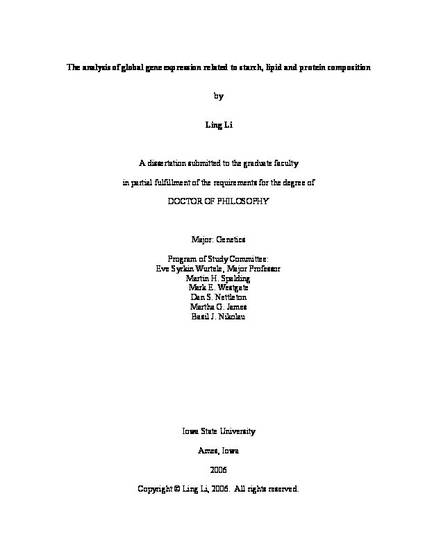
This dissertation provides a greater understanding of starch metabolism and its regulation by using mutants altered in starch accumulation, together with a combination of approaches such as global gene profiling, promoter::GUS/GFP analyses, and genetics;Starch debranching enzymes are critical for starch accumulation. The temporal and spatial co-expression of ISA1 and ISA2 is consistent with previous evidence that they co-function as a protein complex (ISA1/ISA2) for starch synthesis. The extensive temporal and spatial co-expression of ISA2 and ISA3 suggests they might also form a protein complex, taking part in starch metabolism. ISA3 protein is localized in leaf chloroplast, consistent with the possibility of an ISA2/ISA3 complex;Two very different Arabidopsis mutants, the antisense- ACLA mutant (which has a reduced level of ATP citrate lyase (ACL), the enzyme catalyzing the synthesis of cytosolic acetyl-CoA), and the Atss3 T-DNA knockout mutant (loss-of-function of the SS3 starch synthase), both have a starch-excess phenotype. Changes in gene transcript accumulation identified by mRNA profiling comparison indicate changes in a set of starch metabolic genes that are common to both mutants; these genes may contribute to the high-starch phenotype, they include a subset of up-regulated genes of starch synthesis, and genes with changes in transcript level involved in cell wall metabolism, which might reflect carbon partitioning into starch by modification of carbon into cell wall;Acetyl-CoA plays a critical role for plant growth and development. A decreased cytosolic ACL might result in insufficient cytosolic acetyl-CoA substrate for generation of metabolites derived from this molecule. This alteration could affect the plant signaling and oxidative state. It is possible that redox-regulation of starch metabolism results in carbon partitioning into starch. These processes could affect and regulate each other. They represent testable hypotheses that could elucidate metabolic interconnections between starch accumulation and acetyl-CoA metabolism, two disparate metabolic processes;In the Atss3 mutant, a gene (hence referred to as QQ) is highly up-regulated. QQ RNAi mutant lines have a starch-excess phenotype. QQ is predicted to be a tiny protein (59 aa) with no known catalytic motifs; I postulate that QQ has a regulatory role, rather than a catalytic function, in starch accumulation.
Available at: http://works.bepress.com/ling-li/10/
